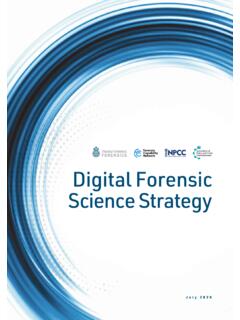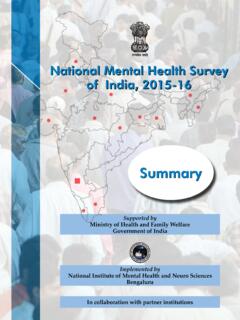Transcription of ‘Do no significant harm’
1 do no significant harm '. Technical Guidance by the Commission Recovery and Resilience Facility ECCWG | 16 February 2021. Background & approach 2. What is do no significant harm ' (DNSH)? The Regulation establishing the Recovery and Resilience Facility (RRF) provides that no measure ( , no reform and no investment) included in a Member State's Recovery and Resilience Plan (RRP) should lead to significant harm to any of the six environmental objectives within the meaning of Article 17 of the Taxonomy Regulation: climate change mitigation climate change adaptation sustainable use & protection circular economy of water & marine resources protection and restoration pollution prevention & control of biodiversity & ecosystems The Commission adopted Technical Guidance on DNSH on 12 February 2021. 3. DNSH is part of the assessment of the plans The Commission has to assess Member States' RRPs based on assessment criteria annexed to the RRF Regulation For each criterion, the Commission must rate the RRP from A to C.
2 For the assessment of DNSH, the Commission has only two rating options: A if no measure leads to significant harm to any of the six environmental objectives C if one or more measures lead to significant harm to any of the six environmental objectives The Commission can only endorse an RRP if no assessment criteria is rated with a C'. 4. How should DNSH be applied? Member States need to provide a DNSH assessment for each and every measure ( each reform and each investment) of their RRP (Article 14 of the RRF Regulation). However, the Commission introduced a simplified approach' for measures that either: have no or an insignificant foreseeable impact on one of the six environmental objectives, or are tracked as 100% supporting one of the six environmental objectives (according to the methodology in Annex IIA of the RRF Regulation), or contribute substantially', pursuant to the Taxonomy Regulation, to one of the six environmental objectives.
3 Such measures are considered compliant with DNSH for the specific environmental objective (but not the remaining objectives). 5. EU law, impact assessments, delegated acts Complying with the applicable EU and national environmental law is a separate obligation. It does not waive the need for a DNSH assessment. Environmental impact assessments (EIAs, SEAs) and sustainability proofing of a measure also do not automatically entail that no significant harm is done but should be taken into account for the DNSH assessment To substantiate compliance with DNSH, Member States are not required to refer to the technical screening criteria' established according to the Taxonomy Regulation, but they have the option to rely upon them 6. Guiding principles 7. Guiding principles scope of the assessment In the context of the RRF, the direct and primary indirect impacts of a measure are relevant for the DNSH assessment The DNSH assessment needs to consider the life cycle of the activity that results from the measure ( apply life cycle considerations).
4 Measures promoting greater electrification ( industry, transport and buildings) are considered compatible with the DNSH assessment for the climate change mitigation objective, provided they are accompanied by increased renewables generation capacity 8. Guiding principles benchmarks For economic activities where there is a technologically and economically feasible alternative with low environmental impact Assess the environmental impact against a no intervention' scenario and in absolute terms ( zero emission cars). For economic activities where there is no technologically and economically feasible alternative with low environmental impact Can demonstrate DNSH by adopting the best available levels of environmental performance in the sector 9. Guiding principles additional considerations Measures related to power and/or heat generation using fossil fuels, as well as related transmission and distribution infrastructure, as a general rule should not be deemed compliant under DNSH for the purposes of the RRF, given the existence of low-carbon alternatives Limited exceptions outlined in Annex III of the DNSH Technical Guidance To ensure that measures are future-proof and do not lead to harmful lock-in effects, and to promote beneficial dynamic effects, accompanying reforms and investments may be required Compliance with DNSH, along these guiding principles, should be integrated in the design of measures, including at the level of milestones and targets 10.
5 In practice: the DNSH checklist 11. How to implement the DNSH assessment? To facilitate the Member States' assessment and presentation of DNSH in their RRPs, the Commission has prepared a DNSH checklist (see Annex I of the DNSH Technical Guidance). Member States should integrate the reply to the questions of the checklist into their RRP when describing each measure (Part 2, Section 8 of the Commission Template). 12. Step 1: filter & simplified approach' (I). As a first step, Member States are invited to complete Part 1 of the checklist, to identify which of the six environmental objectives require a substantive DNSH assessment' of the measure Please indicate which of the environmental objectives below Yes No Justification if No' has been selected require a substantive DNSH assessment of the measure Climate change mitigation Climate change adaptation The sustainable use and protection of water and marine resources The circular economy, including waste prevention and recycling Pollution prevention and control to air, water or land The protection and restoration of biodiversity and ecosystems 13.
6 Step 1: filter & simplified approach' (II). Where the answer is no', Member States are asked to provide a brief justification, why the environmental objective does not require a substantive DNSH assessment', based on one of the following cases: a. The measure has no or an insignificant foreseeable impact on the environmental objective related to the direct and primary indirect effects of the measure across its life cycle b. The measure is tracked as supporting a climate change or environmental objective with a coefficient of 100%. c. The measure contributes substantially' to an environmental objective, pursuant to the Taxonomy Regulation Where the answer is yes', Member States are invited to proceed to Step 2 of the DNSH. checklist for the corresponding environmental objective(s). 14. Step 2: substantive analysis'. For each measure, Member States are invited to use Part 2 of the checklist to perform a substantive DNSH assessment for those environmental objectives selected with a yes'.
7 Under Step 1. Example for climate change mitigation: Questions No Substantive justification Climate change mitigation: Is the measure expected to lead to significant GHG emissions? Member States are asked to confirm that the answer is no', and to provide a substantive explanation and justification of their reasoning Where Member States cannot provide a sufficient substantive justification, the Commission may consider that a given measure is associated with possible significant harm Where useful, Member States can rely upon the list of supporting elements of evidence provided in Annex II of the DNSH Technical Guidance Annex IV of the DNSH Technical Guidance contains several worked out examples 15. Thank you! 16.












